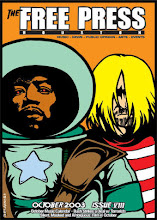Glutton for punishment

I am evidently a glutton for punishment. No I'm not talking about a non-stop listening marathon to the new song by Omar and the Howlers, but rather my choice of cinematic pleasures for the last week. Sure, Choke, Towelhead and Traitor all rocked my world but then the follow up trifecta of Mama Mia Sing Along Edition, House Bunny, and hands down the worst film I have seen in over 20 years Disaster Movie zeroed me back to neutral.
The problem with Mama Mia is not that it's a bad movie - it's badly directed and the tech values are uneven. Who doesn't love the music of Abba? There needs to be a typewriter key that makes a backwards "b."
Specifically the mixture of Grecian locales and London studio green screen effects don't really match lighting wise. Also, the decision to have Pierce Brosnan sing, and not talk-sing or dub lip movements to another singer, was not good. Not good. Audrey Hepburn was dubbed for My Fair Lady and Andy Williams warbled for Lauren Bacall in To Have and To Have Not. Mama Mia's director Phyllida Lloyd directed the stage play and was part of the deal regarding movie rights. The film's studio Universal has shown a bizarre resilience by successfully marketing some of the summer's worst films (Mummy 3, Death Race, MM).
That said, Mama Mia plays like one of those American International beach party movies from the 60s. It's more camp than crap and will be a milestone of this era, say, twenty years from now.
For the Sing Along Edition the words appear in all caps along the bottom of the screen. The letters are blue and when the actors sing the words turn yellow. My personal favorite Abba song "Waterloo" is heard instrumentally at the beginning, but only during the end credits do we hear it sung by the entire cast.
By contrast Disaster Movie, a film made for teens who watch too many illegally downloaded internet movies and too much E! Television, was truly a low point of my movie attending career. There were actually people in the audience from a radio station promotion giveaway. By sharp contrast when fellow Houston film critic Joe Leydon reviewed the film for Variety a mere few hours later (midnight screening) he was the only one in the theater. Until some guy came in and took a piss on the carpet.
To quote from Leydon's blog:
"... I actually was the only person in the theater. At least, that was the case for about 30 or so minutes into the movie. At the 30-minute mark, I noticed a young guy wandering in. (Can’t tell you his age for certain – it was, well, dark.) I thought this was kinda-sorta weird – remember, we’re talking close to 12:40 am at this point – but I figured, what the hell, maybe he just ducked in after seeing another movie in another auditorium of the megaplex. He sat down a few rows ahead of me. But after about five or so minutes, he stood up and… and… well, I am not 100 percent sure about this, but I think he took a leak. Really. Right there in the freakin’ auditorium. On the floor. And then, he left."
Just for the record I was at the same theater that night but I swear it wasn't me, I left House Bunny at 10:40 pm. That's my story and I'm sticking to it.










